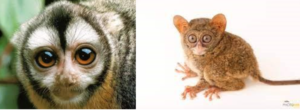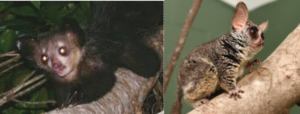Things that Go BOING in the Night
As the sun sets on the forests of Madagascar, the lively hum of insects, birds, reptiles and lemurs ebbs into quiet. Night falls, and a new world begins to emerge in the darkness. The chorus of frogs, the rattle of tenrec spines, and the whisper of moon moth wings fill the night. In the trees, pairs of eyes seem to glow in the moonlight. The nocturnal lemurs of Madagascar are wonderfully mysterious and difficult to observe in the wild, but make up more than 60% of total lemur species. From the world’s smallest primate, Madame Berthe’s mouse lemur, to the world’s largest nocturnal primate, the aye-aye, these incredible creatures are worth staying up late for.

A beautiful night sky in Madagascar.
Out of the approximately 600 recognized species of primate on earth, only a very small percentage are nocturnal. The majority of nocturnal primate species belong to the strepsirrhine suborder, which includes lemurs, lorises, and bush babies. The haplorrhine suborder, which includes tarsiers, monkeys, apes, and humans, has only two nocturnal members: the tarsier and the owl monkey, sometimes called the night monkey. All bush baby and loris species are nocturnal, but the lemur superfamily has both nocturnal and diurnal members, a very unique quality among primates. Around 66 percent of the currently recognized lemur species are classified as nocturnal, but only 20 percent are diurnal. Another 14 percent belong to a less common category: cathemeral. Cathemeralism is a rare activity pattern which occurs almost exclusively in lemurs. Cathemeral lemurs can switch between nocturnal and diurnal activity, usually depending on seasonal food availability. With such a wide range of activity patterns, lemurs are certainly unique among primates.

The owl monkey, or night monkey, is the only nocturnal monkey. Tarsiers are a nocturnal haplorrhine.
Within the lemur superfamily, three out of the five lemur families are strictly nocturnal. These families include Cheirogalidae, Daubentonidae, and Lepilemuridae. There are around 40 known species in the Cheirogalidae family, including fat-tailed dwarf lemurs, mouse lemurs, and fork-marked lemurs. The Lepilemuridae family has 26 species members, also called sportive lemurs. The Daubentonidae family has one member, the aye-aye, which happens to be the world’s largest nocturnal primate! Most nocturnal lemurs are on the smaller side, ranging from around 3 inches long (mouse lemurs) up to about 17 inches long (aye aye). Other nocturnal primates like lorises, bush babies, and owl monkeys are also smaller than their diurnal relatives. While they may vary drastically in size, many nocturnal primates share a suite of characteristics to help them succeed after sundown.

Representatives of three of four nocturnal lemur families (left to right): Cheirogalidae (mouse lemur, fat-tailed dwarf lemur, and fork-marked Llemur), and Daubentonia (aye-aye).
The characteristics that help a nocturnal lemur succeed compared to a diurnal one are really, well, like night and day. Whereas the daylight hours are more difficult to hide in and easier to forage in, the dark brings a whole new set of predators and foraging challenges for the nocturnal species. One common similarity we see in nocturnal animals is enhanced sensory intake, usually obvious in the size and structure of their eyes. The “glowing” eyes that can be witnessed on a night walk in Madagascar are simply a reflective layer of tissue called tapetum lucidum, an adaptation that increases visual sensitivity in low light conditions. While these primates can’t see in the dark, they do have better “night vision” than their diurnal relatives. Some nocturnal primates, like the tarsier, have enlarged eyes and eye sockets to absorb even more light. Just one of the tarsier’s eyeballs is bigger than its brain! Many nocturnal primates also have larger ears to assist with insect foraging, particularly the bush baby, which has independently mobile ears that move like satellite dishes to pick up sound more easily. Nocturnal lemurs are also extremely fast, both to avoid night predators and to better hunt their insect prey.

An aye-aye’s eyes shining in the dark. A bush baby’s large, mobile ears.
From day to night and in between, the primate family is incredibly diverse, especially when it comes to the lemurs. While it can be challenging to conduct research on these fun-sized denizens of the dark , we are continually learning more about nocturnal lemurs and their incredible adaptations to a life without light.
References
Donati, Giuseppe & Borgognini-Tarli, Silvana. (2006). From darkness to daylight: Cathemeral activity in primates. Journal of Anthropological Sciences Journal of Anthropological Sciences. 84. 1-11.
Gursky S, Nekaris K, A, I: Nocturnal Primate Communication: Ecology, Evolution and Conservation. Folia Primatol 2019;90:273-278. doi: 10.1159/000501003
IUCN 2021. The IUCN Red List of Threatened Species. Version 2021-2. https://www.iucnredlist.org.
Zimmermann E. (2012) Primate Serenades: Call Variation, Species Diversity, and Adaptation in Nocturnal Strepsirhines. In: Masters J., Gamba M., Génin F. (eds) Leaping Ahead. Developments in Primatology: Progress and Prospects. Springer, New York, NY. https://doi.org/10.1007/978-1-4614-4511-1_32

